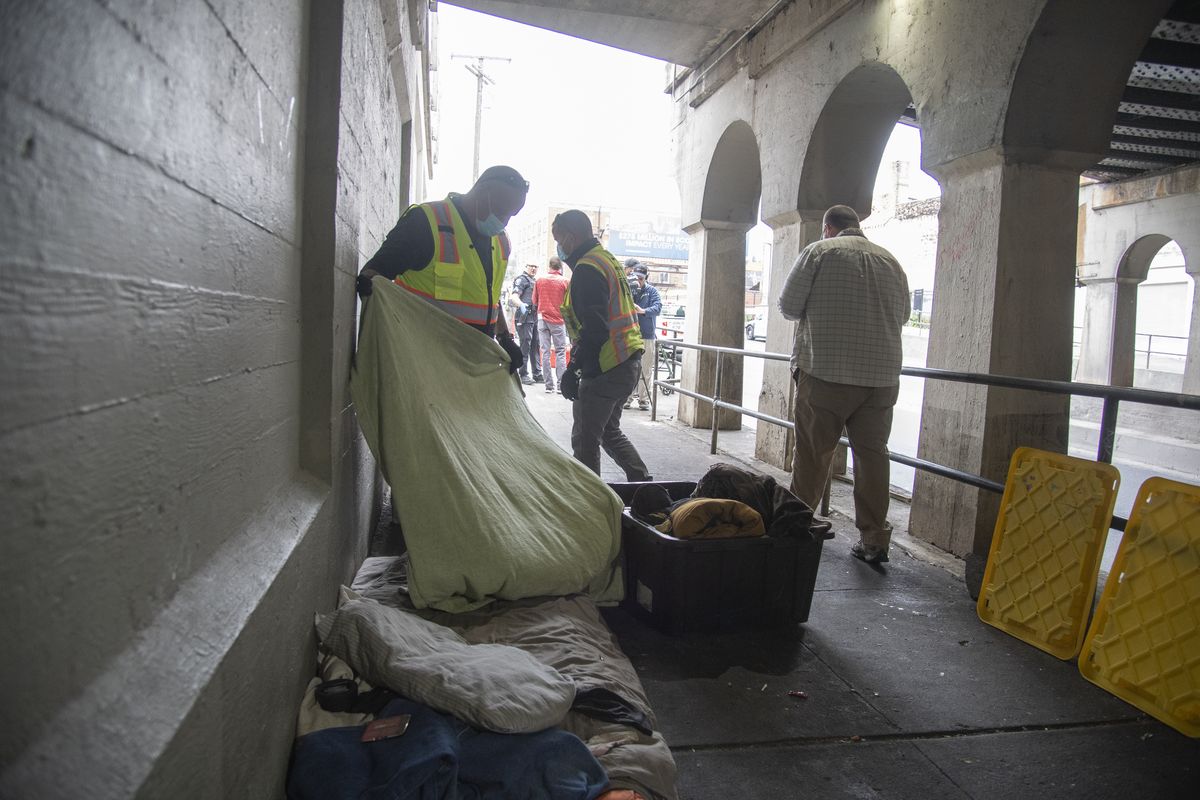This column reflects the opinion of the writer. Learn about the differences between a news story and an opinion column.
Shawn Vestal: Seattle CEOs propose expensive homelessness plan and a way to pay for it

To the list of cities that have been held up as examples of how to fight homelessness successfully – from Salt Lake City’s original housing-first models to the jail-or-treatment ultimatums in Marysville, Washington – you can now add San Diego and Bakersfield, California.
These cities, and their success at bringing chronic homelessness under control, are the focus of a new report commissioned by Seattle business leaders. The gains those cities have made, the report says, have been the result of investments in housing and intensive, individualized outreach and services for homeless people.
The report, “Chronic Homelessness: A Crossroad,” looked specifically at long-term homelessness – those without a place to live for more than a year or who cycle in and out of homelessness regularly. This is the fastest-growing segment of the homeless population in most cities, the one you see on the streets daily, the piece of the puzzle that is both most visible and hardest to address.
The authors, focusing on Seattle but also addressing the rest of the state and region, drew three conclusions:
A) Chronic homelessness is rising sharply all over Washington state, at among the nation’s highest rates, despite large investments in the problem. It’s worst in Seattle but growing rapidly in Spokane and other cities.
B) Making significant progress on chronic homelessness will require spending even more on solutions, with emergency housing and an intensive, “by-name” personalized case management system and aggressive outreach.
C) Not spending more now will cost a lot more in the long run, in terms of public services, business losses and impact on property value.
Oh, and one more very important thing. The report identifies a source of funding that could be used for intensive services focused on the hardest cases: tens of millions of dollars in pandemic relief funds from the American Rescue Plan Act flowing into cities and the state right now.
Some $270 million in ARPA funding is coming to local governments in Spokane County; millions more are also coming to other cities, counties and the state. The Legislature, unfortunately, rebuffed requests to use some ARPA funding the state has received for a broad-based homelessness initiative, but there remain opportunities to use that funding on the local level or in the future.
“We need investment of those monies from cities, counties, and the State,” the report says. “Using ARPA funding for one-time investments in emergency housing and long-term (permanent supportive housing) is the best use of this one-time allocation of federal dollars. … This may be the single biggest opportunity to make progress on housing and homelessness – especially for individuals experiencing chronic homelessness – for generations to come.”
The report did not come from wild-eyed leftists, but from “big-name CEOs,” as one Seattle TV station put it – a group of 21 top executives at some of King County’s biggest companies.
Among its chief concerns are the effect of chronic street homelessness on the community at large, in terms of safety and cleanliness. And yet it does not take the “Seattle is Dying” or “Curing Spokane” approach of proposing incarceration as a solution or engaging in other fantasies about easy fixes.
It puts first things first, treating the top priority as sufficient shelter. Everything else flows from that. In particular, it elevates permanent supportive housing (such as the Haven projects built by Catholic Charities) as the best tool for the long term, but emphasizes the need for more emergency shelter in the short term.
The report accepts the difficult truth that it will be costly – though less costly than doing nothing. The authors estimate that the cost per chronically homeless individual of adopting its recommendations is about $50,000; the cost per chronically homeless individual of doing nothing, in terms of public services, hospital costs, and impacts on business and property owners, is $90,000. Many of the negative consequences are incalculable, as well.
Chronic homelessness has been a growing problem all over the West, but it’s been particularly pronounced in Seattle, and, to a lesser extent, other Washington cities. In King County, the number of chronically homeless people has risen 42% in four years.
Spokane’s increase was 27%, the same rate as the state overall. Our last point-in-time count, before the pandemic, showed we had 541 unsheltered people; the report concludes that our chronically homeless population in that year was 485.
Similarly alarming numbers are seen all over the region. But among major metros in the West, two cities stand out: San Diego and Bakersfield. Both cities follow the Community Solutions Built for Zero Initiative, based on providing sufficient housing while operating a “command center” staffed by case managers and service providers tailoring their efforts to each chronically homeless individual – a “by-name” approach.
They rely on robust real-time data and mobile technology to take their programs to people.
Bakersfield now reports it has achieved a chronically homeless population of “functional zero” in 2020, and San Diego shrank the growth of its chronic homeless population to 2% – the lowest rate of growth of any major Western city from 2016-2020.
The authors of “Chronic Homelessness: A Crossroad” suggest that Washington learn some lessons from those cities. It proposes a series of recommendations that begin with expanding emergency shelter in the short term, building permanent housing for the long-term and creating teams – and providing resources – that approach the problem one homeless person at a time.
It wouldn’t be easy or cheap – just easier and cheaper than the path we’re already on.
